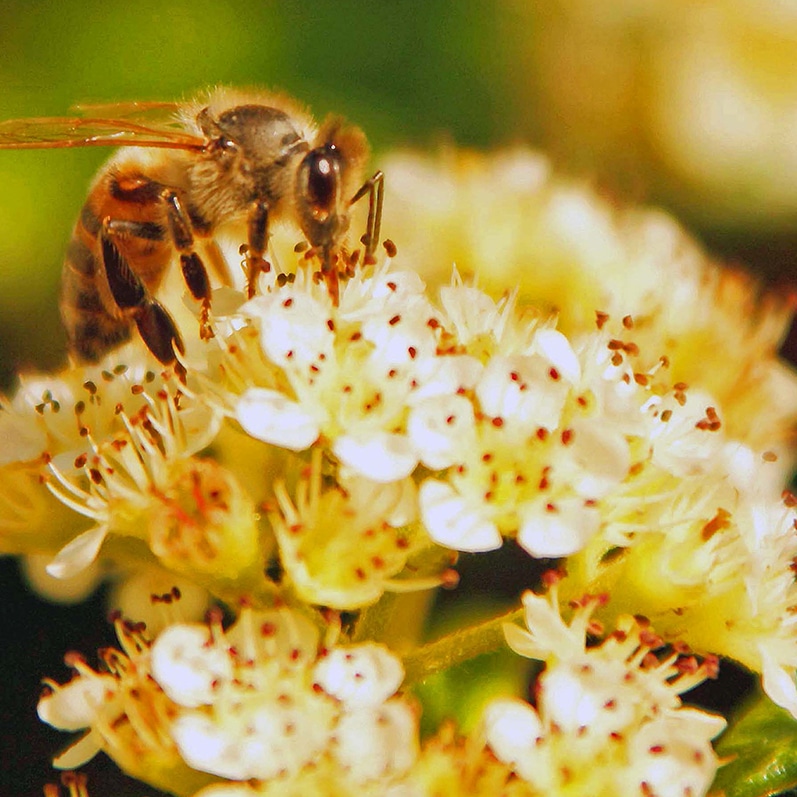
Village at Griesbach Welcomes New Beehives
Village at Griesbach has moved forward with many sustainability initiatives over the years, from green building goals to land preservation, and this year we are welcoming some exciting visitors for our sustainability goals! We are welcoming two beautiful beehives to the community. Griesbach has partnered with Alvéole, a company who advocates for urban beekeeping within communities and city centres.
Alvéole’s mission is to help honey bees thrive in urban areas, and as such ensure that all pollinators are able to grow and flourish. The installation of beehives throughout the city helps native pollinators in a number of ways. Although a common misconception is that bringing in honey bees will install a competition between them and the pollinators native to the area, the exact opposite is true. Alvéole has noticed that even though the number of beehives is increasing, year over year honey production has also increased per-beehive, showing that the increase in pollinators is a help, not a hindrance.

Alvéole has been working to increase urban beekeeping initiatives since 2013, installing thousands of beehive frames into communities to create genuine senses of connection to nature. Griesbach is proud to help this organization raise awareness about sustainability and environmentally friendly practices. Bees and pollinators are a crucial part of food production and the ability for plants to grow, agriculture and our environment as we know it rely heavily on pollinator populations. That’s why Village at Griesbach is so excited to partner with Alvéole, they are ambassadors for environmental stewardship, and Griesbach seeks to be a part of it.
Honey bees have an incredible potential to inspire community members, companies, and organizations of all shapes and sizes to make concrete changes aimed at saving all pollinators and protecting the future of our environment along the way, something that is near and dear to the community of Griesbach’s heart.
Fun Facts about Honeybees in Griesbach


- Bees only resort to stinging when they feel their colony is threatened. This shouldn’t come as a big surprise when you consider that, unlike wasps, bees die shortly after delivering a sting. Their stinger gets stuck and tears off, taking part of their abdomen with it. Bees have no motivation to sting unless aggression is demonstrated towards them.
- At the height of the season, each beehive contains up to 50,000 individuals. Approximately 90% of the bees in the hive are workers (females), and 10% are drones (males).
- There is only one queen per hive. In ideal conditions, Her Majesty can live for up to five years. She requires a court of bees to help feed, hydrate and clean her, as she is too busy laying up to 2,000 eggs daily to do it herself.
- During the winter, the bees will stay comfortable in the warmth of their hive where they’ll maintain an internal temperature of up to 35 degrees Celsius. To do so, they form a tight cluster around the queen and keep warm by contracting their thoracic muscles. When winter is over, strong hives are divided into several smaller ones – a bit like perennial plants – to distribute the hive’s strength and population size.
- Bees do not eat anything other than nectar and pollen, as opposed to wasps, who feed their young with animal or insect protein.
- Bee colonies flourish in urban areas. This is because they require an environment fulfilling three criteria: the absence of pesticides, an abundance of water and floral resources, and a temperate climate.
- Bees communicate with pheromones, smells that cause a response in other members of the hive.
- It is estimated that bees need to eat 9 pounds of honey to produce a single pound of beeswax.
- Each hive produces honey that reflects the ecosystem surrounding it. A hive’s honey encompasses flavours from each flower visited by the bees.
- Bees fly the equivalent of four times the earth’s circumference to produce two pounds of honey. Bees visit up to 4,500,000 flowers to produce every kilogram of honey.

How to Act Around an Urban Beehive
Honey bees are very docile, focused mainly on bringing floral resources back to their colony. Bees are not aggressive, but they can be defensive, and it’s best to give the bees a bit of space to allow them to carry out their duties without interference.
Each Alvéole beehive has an entrance located at the front of the bottom box about six inches off the ground. You may notice bees congregating here in the summer months in an effort to cool off. It’s at this entrance that you’ll likely see bees entering and exiting the hive, carrying nectar or pollen, following their upward flight path.
Bees take off and land much like airplanes at your local airport. No matter the elevation of the hive they’ll take off and fly upward reaching an altitude of twenty feet at a maximum of six feet in front of the hive. That’s why it’s best to always stay at least 10 feet away from a hive.
Village at Griesbach’s Beehives

Village at Griesbach is incredibly excited about this urban beekeeping initiative! Village at Griesbach is committed to providing sustainable and environmentally friendly leadership, and this partnership with Alvéole is another fantastic opportunity for the community’s green opportunities. We can’t wait to see how the honeybees help our community’s gardens and greenspaces flourish! You can follow along and keep up to date with the Griesbach beehive project online! Follow along on the Griesbach Alvéole portal!
